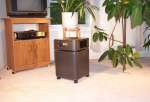Search engine visitors - click here to access entire "$ensible Home" web site
Click here to see a descriptive illustration of several types of efficient room air cleaners.
Dear Jim: I need a room air cleaner for my son's allergies. I see ads for ones with no fans and others called "HEPA". How can I tell which types are most effective and which use less electricity? - Janice F.

A: There is a huge array of various room air cleaner designs and styles available. Unlike most home products, you cannot use the price of a room air cleaner as an indication of its effectiveness. Also, some of the flashy television advertisements for room air cleaners are long on claims, but the products are short on actual performance and specifications.
I called the 800 phone number shown in a television ad for one of the expensive, no-fan air cleaner models which consumes little electricity. After pressing them for the CADR (clean air delivery rate - see following description) rating, that specific model was effective for a room not much larger than a closet. Models with fans use more electricity, but selecting one with multiple speeds allows you to run it on the efficient low speed.
One of the best methods to compare air cleaners is by their CADR. This rating indicates the effectiveness of a room air cleaner as determined by testing per the AHAM (Association of Home Appliance Manufacturers) standards. The CADR is recognized as the standard by the U.S. Environmental Protection Agency and the American Lung Association as a good representation of an air cleaner's effectiveness.
The CADR rating, if the room air cleaner manufacturer had its products tested and certified, should be listed on the packaging or in the user manual. You will see three CADR numbers referring to household dust, tobacco smoke and pollen. Even though there are other pollutants in a home, such as mold, pet dander, etc., the range of sizes of the former three pretty well cover the gambit of most particles in room air.
The CADR numbers can range from less than 50 for small air cleaners to more than 300 for large effective ones. Also some air cleaners are better at removing smoke, which are some of the smallest particles in room air, whereas other air cleaners are better at removing pollen, which are relatively large particles. For this reason, first talk with your allergist to determine to which allergens your son is allergic and must be removed from his room air.
In order to circulate enough room air through the air cleaner to be effective, the air cleaner should have a fan. An air cleaner rated to clean a larger room will have a larger fan and will use more electricity. You may want to run it on high speed for only 30 minutes before bedtime and then switch it to a more efficient low-speed setting over night.
If your house has hot water radiant heat or electric infloor heating, the air cleaner may not be needed all night. To save electricity, put it on a timer and run it for about 15 minutes after your son is in bed. With these types of nonforced-air heating, once there is no movement by people in a room, particles and allergens should not become airborne on their own. When your son gets up in the morning and kicks up some dust, run the air cleaner again while he is dressing.
For effective room air cleaning, the AHAM recommends the CADR of a room air cleaner should be 2/3 of the square footage of the room. For example, if you son's bedroom is 10 x 12 feet and he is allergic to pollen, select an air cleaner with a pollen CADR of 80 as a minimum. You can also select one with a higher CADR to clean the air faster, but it will likely cost more and use more electricity.
In my own home, I use a HEPA room air cleaner with a carbon element in my bedroom. The HEPA and carbon (reduces odors and some volatile chemicals) filters need to be replaced periodically, but they are very effective and reasonably quiet. Be sure to get a true HEPA model. To be a true HEPA, it must state it removes 99.97 percent of all particles 0.3 microns or larger.
Another effective design uses electrostatic precipitator technology with a circulation fan. I use one near my pellet/corn stove. These give the room air one charge and a collection plate the opposite charge so particles stick to it. These often include a wire mesh prefilter to capture large particles. Both the prefilter and the collection plates are periodically removed and washed. These are particularly effective for tiny particles such as smoke.
Instant Download Update Bulletin No. 718 - buyer's guide of the 16 most effective room air cleaner manufacturers (55 models) listing maximum cfms, clean air delivery rates (CADR's) - dust, tobacco smoke and pollen, filter types (HEPA, electronic, electrostatic, pleated media, high density), recommended room size in sq. ft. for each model, speeds, weights, features, prices, a sizing selector chart, illustrations and descriptions of various models.
Dear Jim: I have a gas furnace in my house. I keep it set at 68 degrees during the winter. I was told not to set it lower when I am gone and back up later because it will use more gas. Is this true? - Kerry S.
A: This is incorrect. You should always set the thermostat lower when you are away from your house. An electronic thermostat makes this more convenient to do. Whenever the thermostat is lower you are saving money.
The amount of heat your house loses is primarily a function of how warm you keep it. When the thermostat is set lower and the house is cooler, less heat is lost. When less heat is lost, the furnace has to run less.